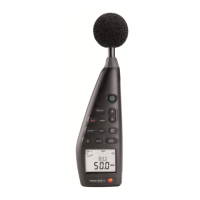5 Using the product
18
5.8. Measuring
Information and recommendations
• Sound waves can be reflected off walls, ceilings and other
objects. If not handled correctly, the measuring instrument
housing and the person conducting the measurement are also
disruptive factors within the sound field and can result in
incorrect measurement results.
• Not only can the instrument housing and the person operating
the instrument impede the sound which comes from a particular
direction, they may even cause reflections, resulting in
significant measurement errors. Experiments have shown, for
example, that at frequencies around 400 Hz the body can
cause errors of up to 6 dB if a measurement is carried out less
than one meter away from the person. This error is smaller at
other frequencies, but a minimum distance should still be
observed. Generally, it is recommended that the measuring
instrument is held at least 30 cm - even better 50 cm - away
from the body.
• We recommend fitting the instrument to a tripod for exact
measurements
• Absolute pressure dependency: The measuring instrument is
calibrated at a height of 0 m above sea level in the factory.
Measurements at other heights give rise to measurement errors
which can be corrected using a table (see technical data).
Please subtract the corresponding offset value from the
measured value (e.g. - 0.1 dB for measurements at a height of
500 m above sea level). Prevent this measuring error by
adjusting the measuring instrument at the corresponding height
before (and after) each measurement. Follow the instruction
manual for the calibrator.
• Windscreen: The windscreen included in the delivery should
generally be set up for measurements outdoors or if the air is
moving. Wind noises around the microphone will cause a
measuring error as the useful signal (from the noise source)
and the wind noise will be added together.
The slight effect of the windscreen on the measurement result
is illustrated in the diagram on page 10.
• Overmodulation and undermodulation: With every
measurement cycle, the sound level meter checks whether the
measured sound level is within the scope of the measuring
range. Deviations are indicated by “Over” or “Under” on the
display. However, the criteria for overmodulation and
undermodulation are different. Overmodulation is signalled if
the maximum value (peak value e.g. short sound pulse, bang)

